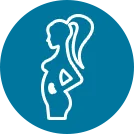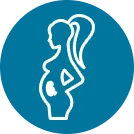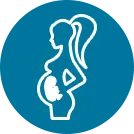


Obstetrics and gynaecology (O&G) are two specialties that deal with the care of women during pregnancy and childbirth, as well as the diagnosis and treatment of diseases affecting the female reproductive organs.
Obstetricians and gynaecologists are specialists in women's health. O&G specialists cover both areas of specialties, including childbirth and delivery, as well as women’s general health of the female reproductive system.
Obstetrics focuses primarily on care during pregnancy, childbirth, and postpartum. In addition to caring for the health of the foetus, obstetricians’ responsibilities include monitoring the uterus during pregnancy and other obstetrical conditions. These are conditions associated with pregnancy or childbirth.
Gynaecology focuses on women’s reproductive health, as well as the functions and disorders distinct to women. Gynaecologists diagnose and manage disorders specific to the reproductive system, including preventive care, cancer screenings, and physical examinations.
For expectant mothers and their developing babies, antenatal care consists of medical and midwifery attention, such as pre-conception care and pregnancy diagnosis, routine antenatal screening, ultrasound scanning, specialised investigations, and cardiotocography (CTG).
Good antenatal care allows the mother to care for herself and her baby. Medical advice, good nutrition, exercise, rest, and avoiding unwanted risks are important for a successful pregnancy.
Being aware of the ways that your growing baby is affecting your body will help you to better prepare yourself for changes as they happen. It is also helpful to be aware of the specific risk factors and associated medical tests for each of the three trimesters.

Find out what to expect in the first trimester of your pregnancy journey.

Glucose screening test: This test checks for gestational diabetes, a temporary condition which can develop during pregnancy.
Find out what to expect in the second trimester of your pregnancy journey.

Find out what to expect in the third trimester of your pregnancy journey.

Ultrasound for foetal nuchal translucency (NT)
This test measures the area at the back of the foetus’ neck for thickening or extra fluid. Area that is thicker than normal may indicate Down syndrome, heart problems or trisomy 18. However, this is not a routine test, and it is usually conducted by a maternal-foetal medicine specialist.

Second trimester detailed scan
This routine scan is typically conducted between weeks 20 and 24 of the second trimester. Also known as foetal anomaly scan, it is primarily conducted to assess the foetus’ anatomy and detect structural abnormalities of the foetus.
Find out what to expect in the second trimester of your pregnancy journey.

The third trimester is an exciting time - your baby is almost here! Your doctor might check your baby’s presentation to ensure that it is head-first before labour.
If your baby is breech (feet-first or rump-first), your doctor may physically manipulate your baby to the correct position by applying pressure on your abdomen. This is usually performed with ultrasound guidance. A caesarean section delivery is another option for breech babies.
Complicated pregnancy-related conditions include:




If your pregnancy is considered high risk, your doctor may refer you to a maternal-foetal medicine specialist, who is an obstetrician with special training in high-risk pregnancy care.
To learn more about gynaecological conditions and symptoms, select one of the following icons.
The uterus or womb is an inverted pear-shaped organ with thick muscular walls. It is located within the pelvis, between the bladder and rectum.
The uterus is composed of three layers: the outer peritoneal layer, the middle muscular layer, and the innermost lining, known as the endometrium. The endometrium thickens and prepares for implantation each month during the menstrual cycle, and if pregnancy does not occur, it is shed during menstruation.
On top of that, the muscular walls of the uterus can stretch and expand to accommodate a growing foetus. During labour, the muscular walls contract to push the baby out through the cervix and the vagina.
The cervix is the lower part of the uterus that extends into the vagina. Occasionally, it is referred to as the 'neck of the uterus.' The cervical os, an aperture located in the cervix, is capable of expanding during childbirth to facilitate the passage of the baby through the vaginal canal.
The cervix produces mucus that assists in the movement of sperm through the reproductive system and can vary in consistency throughout a woman's menstrual cycle to support fertility.
The cervix is also a crucial site for routine cervical cancer screening tests such as Pap smear that help detect any abnormal cells that could be a sign of cancer.
The vagina is a muscular tube-like structure that connects the external genitals (vulva) to the cervix. It is approximately 7cm to 9cm in length. The opening of the vagina is located between the urethra (where urine comes out) and the anus. The vagina is often called the birth canal as it provides the passageway for the delivery of a baby.
The ovaries are a pair of oval-shaped organs located in the pelvis on either side of the uterus. They produce, store, and release eggs (ovum) into the fallopian tubes during ovulation. The ovaries also produce hormones such as oestrogen and progesterone, important for regulating the menstrual cycle and maintaining reproductive health.
Fallopian tubes are also known as uterine tubes that connect the ovaries to the uterus. Each tube is about 10cm long. The fallopian tubes are divided into the infundibulum, ampulla, and isthmus. The infundibulum is the funnel-shaped opening at the end of the fallopian tube nearest to the ovary. It is lined with finger-like projections called fimbriae that help to sweep the egg released from the ovary into the tube. The fertilisation of the egg by sperm usually occurs at the ampulla.
The inner lining of the fallopian tubes is made up of ciliated cells and secretory cells. The cilia are hair-like structures that move in a coordinated way to help sweep the egg towards the uterus. The secretory cells produce substances that nourish the sperm and the developing embryo.
Click the “+” symbol on the uterus diagram below to find out more about various gynaecological conditions and symptoms.
Gynaecological examinations serve several purposes. The most important thing is to diagnose any abnormalities as quickly as possible. The sooner the treatment, the better the chances of managing or recovering from the condition.
Gynaecological examinations serve several purposes. The most important thing is to diagnose any abnormalities as quickly as possible. The sooner the treatment, the better the chances of managing or recovering from the condition.
Please note that these are recommended ages. Your doctor will advise you if otherwise.
Basic health screening
Ages: 18 years and above
How often: Once a year
Cervical cancer screening (Pap Test)
Ages: 21 to 65
How often: 3 years once
Note: HPV infection is the leading cause of cervical cancer.
Breast cancer screening (Mammogram)
Ages: 40 to 74
How often: 2 to 3 years once
Colorectal cancer screening
Ages: 50 to 75
How often: 10 years once
Bone density test
Ages: 65 and older
How often: 3 to 5 years once
Learn more about 7 health screening tests that every woman should go for.
Gynaecology refers to the specialty that treats medical conditions that affect the female reproductive system - cervix, uterus, ovaries, fallopian tubes, and vagina. A gynaecologist’s focus is on the non-pregnancy aspects of a woman’s reproductive health. These include:
Once you schedule an appointment with an Obstetrics and Gynaecology specialist, the doctor will initially ask you a series of questions about your condition or symptoms.
An OB/GYN appointment may involve several types of examinations. The examination that an OB/GYN may choose to perform depends on the reason for a patient’s visit, their sexual activity and age.
These examinations include:
The caring and dedicated team of Obstetrics & Gynaecology specialists is available for consultation and to provide the best care. Get in touch with us to book an appointment today.


Wait a minute